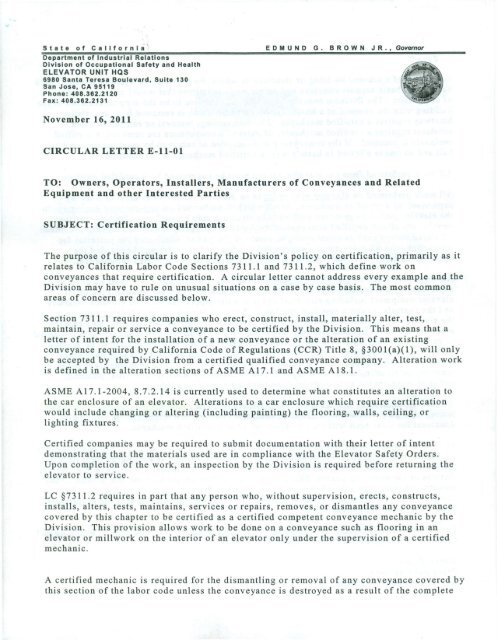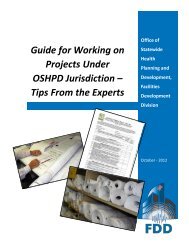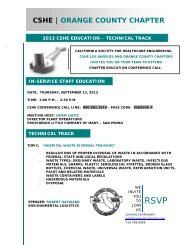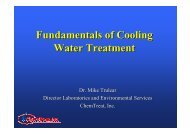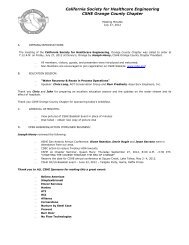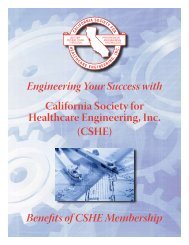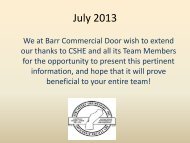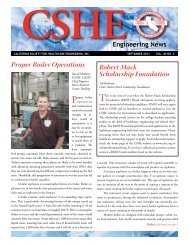Certification Requirements CA Labor Code 7311.1 and 7311.2 - CSHE
Certification Requirements CA Labor Code 7311.1 and 7311.2 - CSHE
Certification Requirements CA Labor Code 7311.1 and 7311.2 - CSHE
You also want an ePaper? Increase the reach of your titles
YUMPU automatically turns print PDFs into web optimized ePapers that Google loves.
State of California"<br />
Department of Industrial Relations<br />
Division of Occupational Safety <strong>and</strong> Health<br />
ELEVATOR UNIT HQS<br />
6980 Santa Teresa Boulevard, Suite 130<br />
San Jose, <strong>CA</strong> 95119<br />
Phone: 408.362.2120<br />
Fax: 408.362.2131<br />
E D M U N D G. B ROW N JR., Governor<br />
November 16, 2011<br />
CIRCULAR LETTER E-11-01<br />
TO: Owners, Operators, Installers, Manufacturers of Conveyances <strong>and</strong> Related<br />
Equipment <strong>and</strong> other Interested Parties<br />
SUBJECT: <strong>Certification</strong> <strong>Requirements</strong><br />
The purpose of this circular is to clarify the Division's policy on certification, primarily as it<br />
relates to California <strong>Labor</strong> <strong>Code</strong> Sections <strong>7311.1</strong> <strong>and</strong> <strong>7311.2</strong>, which define work on<br />
conveyances that require certification. A circular letter cannot address every example <strong>and</strong> the<br />
Division may have to rule on unusual situations on a case by case basis. The most common<br />
areas of concern are discussed below.<br />
Section 7311 . 1 requires companies who erect, construct, install, materially alter, test,<br />
maintain, repair or service a conveyance to be certified by the Division. This means that a<br />
letter of intent for the installation of a new conveyance or the alteration of an existing<br />
conveyance required by California <strong>Code</strong> of Regulations (CCR) Title 8, §3001(a)(1), will only<br />
be accepted by the Division from a certified qualified conveyance company. Alteration work<br />
is defined in the alteration sections of ASME A17.1 <strong>and</strong> ASME A 18.1.<br />
ASME AI7.1-2004, 8.7.2.14 is currently used to determine what constitutes an alteration to<br />
the car enclosure of an elevator. Alterations to a car enclosure which require certification<br />
would include changing or altering (including painting) the flooring, walls, ceiling, or<br />
lighting fixtures .<br />
Certified companies may be required to submit documentation with their letter of intent<br />
demonstrating that the materials used are in compliance with the Elevator Safety Orders.<br />
Upon completion of the work, an inspection by the Division is required before returning the<br />
elevator to service.<br />
LC §<strong>7311.2</strong> requires in part that any person who, without supervision, erects, constructs,<br />
installs, alters, tests, maintains, services or repairs, removes, or dismantles any conveyance<br />
covered by this chapter to be certified as a certified competent conveyance mechanic by the<br />
Division. This provision allows work to be done on a conveyance such as flooring in an<br />
elevator or millwork on the interior of an elevator only under the supervision of a certified<br />
mechanic.<br />
A certified mechanic is required for the dismantling or removal of any conveyance covered by<br />
this section of the labor code unless the conveyance is destroyed as a result of the complete
Page 2<br />
demolition of a secured building or structure or where the hoistway or wellway is demolished<br />
back to the basic support structure <strong>and</strong> no access is permitted that would endanger the safety<br />
of any person. The Division considers the support structure to be the support skeleton of the<br />
building with the absence of a hoistway. An elevator which is removed from an existing<br />
hoistway requires a certified mechanic. The dismantling, removal or relocation of an<br />
escalator requires a certified mechanic. If parts of a conveyance are removed, a certified<br />
mechanic is required. If the conveyance is dismantled or removed by machine or wrecking<br />
ball <strong>and</strong> no one is allowed in harm's way, a certified mechanic is not required.<br />
All work performed from the elevator car top must be supervised by a certified mechanic.<br />
All work performed on elevator eguipment in an elevator pit/hoistway must be done by or<br />
supervised by a certified mechanic. Work which is performed on non-elevator equipment in<br />
the elevator pit/hoistway or the pit/hoistway structure may be performed by non-certified<br />
people only after a certified conveyance mechanic has properly l<strong>and</strong>ed the elevator, removed<br />
all stored energy such as counterweight, removed the power, eliminated the potential for<br />
interaction with all other moving equipment in adjacent hoistways <strong>and</strong> barricaded the<br />
opening. In some cases the Division will require a plan to be submitted for approval.<br />
All work performed on elevator equipment in the elevator machine room must be done by or<br />
supervised by a certified mechanic. The installation, alteration, <strong>and</strong> maintenance of all<br />
elevator equipment including electrical <strong>and</strong> hydraulic piping between the elevator hoistway<br />
<strong>and</strong> the controls require a certified mechanic. Work performed on non-elevator eguipment in<br />
the elevator machine room does not require a certification by the Division but may require<br />
other certifications not addressed by this code. Access to an elevator machine room is limited<br />
to qualified persons only. This does not mean that a person must be certified to be granted<br />
access to a machine room. This means that building owners or engineers may only grant<br />
access to qualified people when necessary to perform duties such as changing light bulbs,<br />
repairing air h<strong>and</strong>ling units, door repairs, fire extinguisher maintenance, floor painting,<br />
sprinkler maintenance <strong>and</strong> smoke/heat detector maintenance in this space.<br />
All testing required by the Elevator Safety Orders including monthly fire phase one <strong>and</strong> two<br />
testing must be performed by a certified competent conveyance mechanic. A compliance<br />
document for these tests will only be accepted from a certified mechanic.<br />
LC §7300.4 states in part: Work exempted pursuant to this section includes, but is not limited<br />
to, routine non-mechanical maintenance, such as cleaning panels <strong>and</strong> changing light fixtures.<br />
This does not include changing the bulbs or fixtures of elevator specific items such as arrival<br />
fixtures or car operating panels. This allows non-certified people to clean the interior of the<br />
elevator, vacuum door sills, change accessible light bulbs <strong>and</strong> change light fixtures. The<br />
Division will only allow a non-certified person to change a light fixture if it can be properly<br />
done from inside the car enclosure.<br />
For purposes of this circular letter, the Division defines supervision as a critical watching <strong>and</strong><br />
directing of activities as in direct supervision.<br />
Debra Tudor<br />
Principal Engineer<br />
DOSH-Elevator Unit HQS


